So I Have Been Playing Prison Architect Recently
For the second time. I gave it a shot last year when it was still in Early Access and while it was certainly playable, there was no real tutorial and I had no intention at the time to learn everything about the game by going through the official wiki or something. Now, the situation has changed with the official release of the game, and the addition of a Campaign mode.
Campaign? Maybe the name is confusing. If you are expecting a RTS-like campaign mode that will take dozens of hours to complete and justify buying the game in itself, you would be disappointed. The campaign mode in Prison Architect is basically nothing but a long tutorial with a little story attached to it. Its goal is to make you learn how to play the game step by step, and it does it remarkably well. You start in the first mission by constructing an execution chamber for a inmate sentenced to the death row. This kind of thing would become trivial later on, but at first it teaches you the usual flow for building construction:
- First, start with the foundations on a surface of your choosing.
- Position one of several entrances (such as doors).
- Define the purpose of your building’s interior by assigning a “room” type to it.
- Add the necessary items needed in that particular type of room.
- Connect your electrical network to it, as well as the water system if required.
All these steps make perfect sense, but there is definitely more manual work and mental training needed compared to your usual City building game, for example.
The second mission of the campaign starts with a crisis: a fire has started in the prison and you have to prevent it from spreading and save as many prisoners as possible. This story trope introduces you to the Emergency troops available in Prison Architect - starting with firemen. After the fire is dealt with, you will have to destroy the remains and rebuild the aisle of the prison that burned - again teaching you the basics of demolition and letting you progressively experiment with the planning of your prison’s architecture. There will be injured prisoners and you will have to take care of their recovery in the infirmary along with your doctor staff.
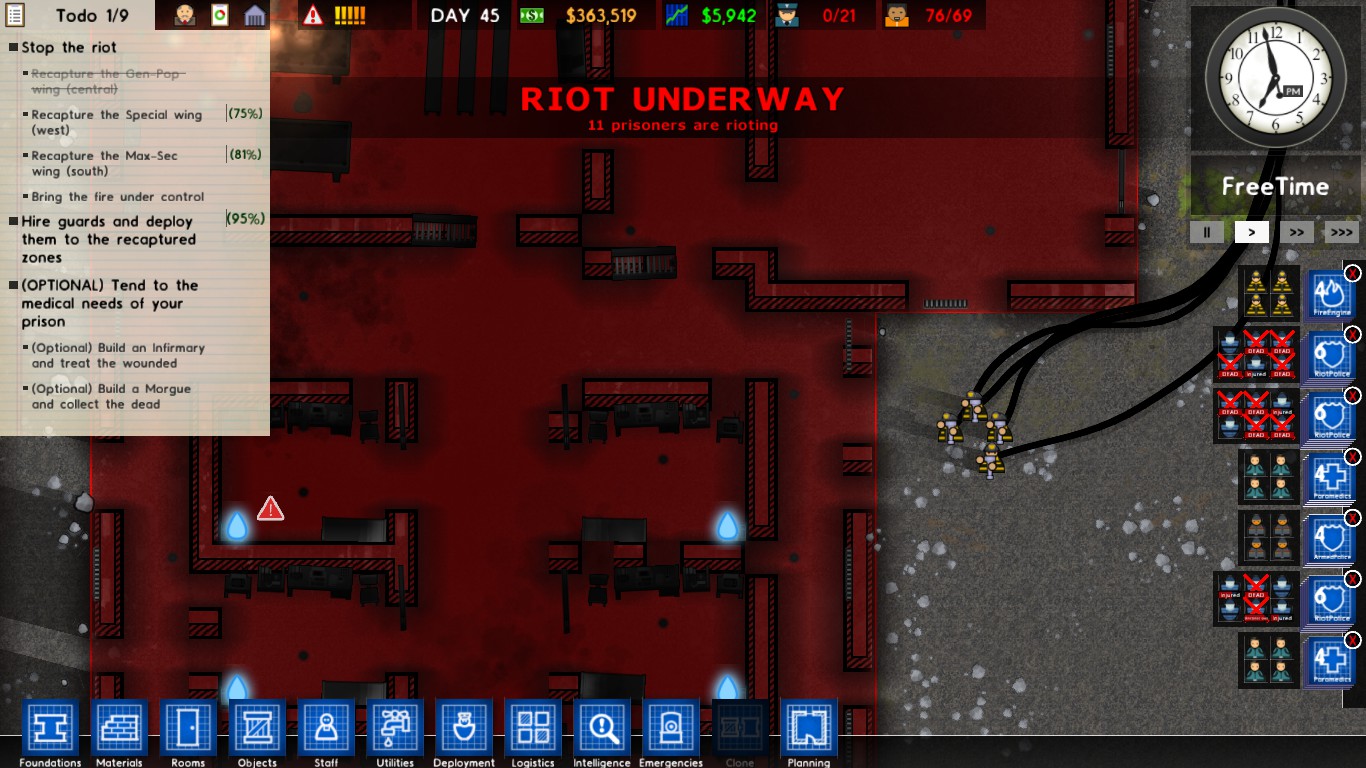 Firemen have just stopped the fire in this aisle.
Firemen have just stopped the fire in this aisle.
The campaign’s story does a great job to tie in all these little tutorials into a larger story, and everything is very much seamless as you go on. By the 4th mission you will have grasped most of the concepts of the game, and you will even have dealt hands on with a large scale prison riot, requiring the involvement of armed forces to restore order once and for all (it’s almost like Hotline Miami then!).
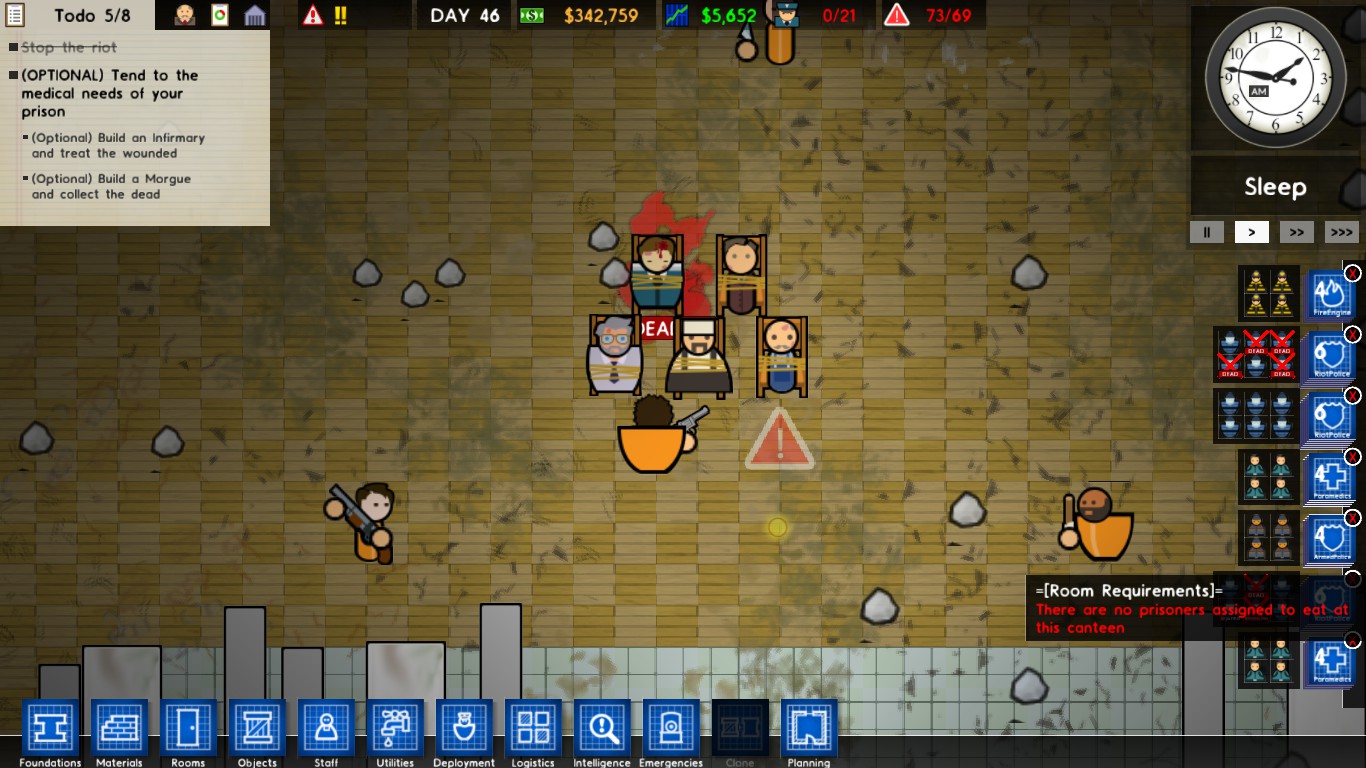 One of the campaign episodes features an hostage situation.
One of the campaign episodes features an hostage situation.
The fifth mission of the campaign is almost like a real thing, making you build your prison from scratch - and reach some arbitrary goals in order to end the game at some point and close the tutorial.
There is just about the right amount of direction to make you learn at your space - and while the interface could be more practical, after a couple of hours in the campaign mode you will be ready to start in the sandbox mode, which is the real meat of the game.
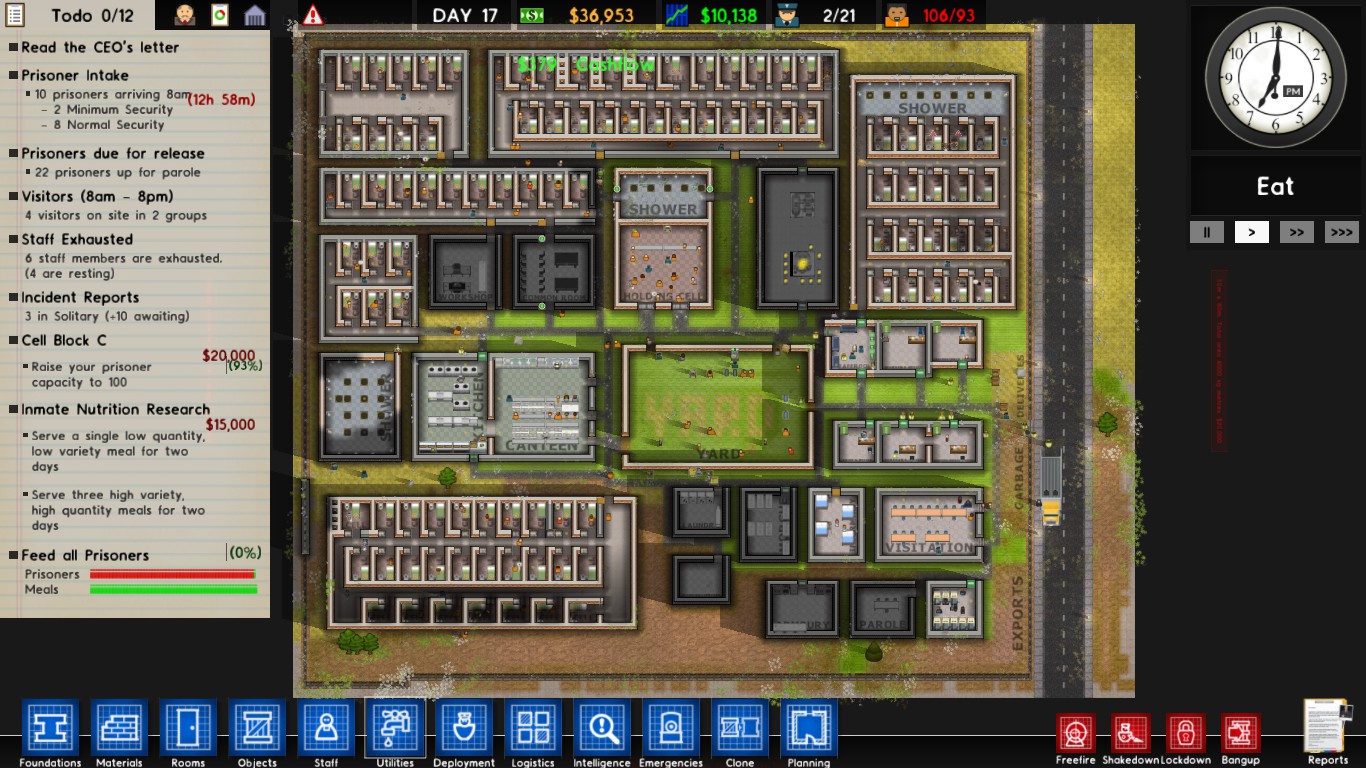 My new prison in the sandbox mode, after a couple of hours.
My new prison in the sandbox mode, after a couple of hours.
Prison Architect is a very complex game. It may not aim to be realistic, but in terms of simulation it goes very, very far. Individual prisoners have their own profile and story of crimes, their own personalities - some of them more dangerous than others. You can manage this level of chaos by assigning different levels of security in your prison zones - for example by regrouping your most dangerous inmates in a separate building, and ensuring that they are watched over by armed guards instead of just regular guards. The game makes you naturally expand your prison through a series of well thought gameplay mechanisms: the system of Grants.
Grants act like government or private entities loans or donations, provided in exchange for you to complete a set goal. For example, expanding your prison to 50 cells will be one of such goals, and you will get something like 20 000 USD to get started and you get another 20 000 USD once you achieve it. Cash is a necessary element to hire more staff and unlock many more options to control your prison and make it flourish in one way or another. Through the overall research tree, you could go full blown into surveillance systems, along with trained dogs and armed guards for repression.
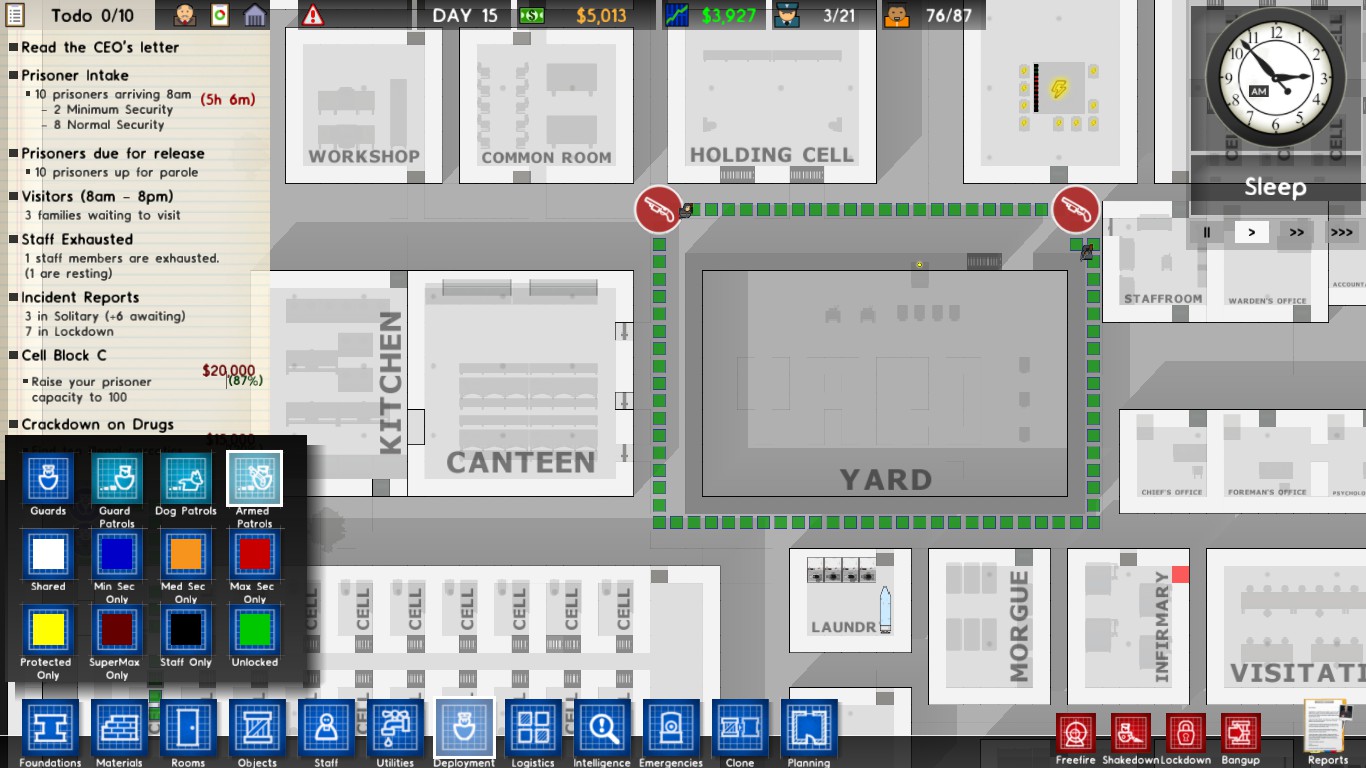 The Deployment view can let you organize patrols… and armed patrols.
The Deployment view can let you organize patrols… and armed patrols.
Or you could decide to work for the well-being of your inmates by providing them education and rehabilitation programs. Such programs can involve inmates labor, which can be turned into cash as well (or reduce the amount of work that befalls your staff, by putting the inmates to work in the kitchen!).
Grants are a great way to bring you some positive cash flux, while ensuring you spend your resources to grow your prison both in size and capabilities. And ultimately, it guides you, gives you direction so that you do not drown yourself in the ocean of options the game provides.
As the prison grows, the game will put more pressure on you: there will be drugs or weapons traffic in your prison, prisoners may get more and more upset by their living conditions and start riots that could easily go out of control and result in prisoners escaping. Some prisoners will dig tunnels to exit your facilities as well, so you’ll need to have regular patrols along your perimeter to reduce the risk of this happening. Fights will occur between prisoners resulting in accidental deaths sometimes - raising penalties for your management and making the valuation of your prison drop to zero in no time.
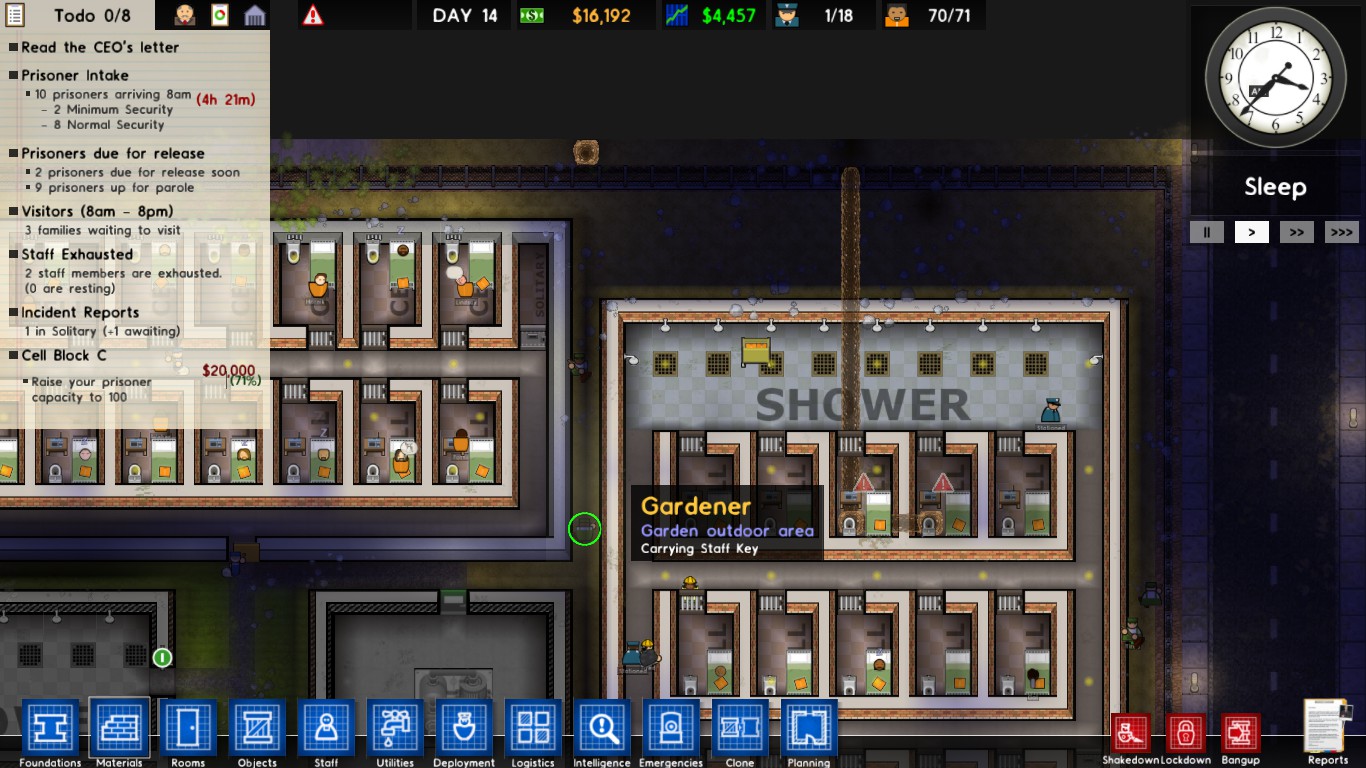 Some prisoners dug tunnels through the toilets!
Some prisoners dug tunnels through the toilets!
If that is not tough enough for you, you can even have the game trigger random events once in a while to spice things up, or have the option for prisoners to form gangs in your prison and make your life even more difficult. In order to keep things under control, if you go for repression, you will be able to customize the punishments your guards provide for each infraction to the prison code. For example, making a prisoner stay in solitary containment for a single day if they attack a guard, instead of a couple of hours. It may piss them off a lot, however, so finding the proper balance is key. Like all simulators, Prison Architect rewards experimentation.
So, is the game enjoyable right now?
OH YES.
I can definitely declare that it has become very entertaining, and that you will be able to sink many hours into it before getting bored. What I do not know, however, at this stage, is whether you can achieve a kind of “win” where the challenge disappears completely. This is always the key problem with such games: once you get the hang of it, is there anything new that would bring some difficulty, something to pursue at the later stages of the game ? What will keep you going ?
I will need to sink many more hours in the game to be able to answer that question.
But that’s a good problem to have: a great game to play with, to see how far it can go.
